Medical-Surgical Nursing Essay: Legal and Ethical Issues (NURS12155)
VerifiedAdded on 2023/04/23
|10
|2881
|182
Essay
AI Summary
This essay delves into the critical legal and ethical issues within the realm of medical-surgical nursing, emphasizing the significance of effective communication in patient care. Drawing from a case study involving Mr. Bb, the essay scrutinizes the nursing care provided, highlighting violations of the Registered Nurse Standards for Practice and the Code of Conduct. It examines how inadequate assessments, failure to involve family, and poor communication patterns contributed to adverse outcomes. The analysis underscores the importance of comprehensive health assessments, adherence to ethical guidelines, and collaborative communication between healthcare professionals to prevent medical errors and ensure quality patient care. The essay concludes by stressing the need for nurses to stay updated with current knowledge and skills to provide the best possible care, as well as the significance of communication in improving patient outcomes in healthcare settings. The document is available on Desklib, a platform providing AI-based study tools for students.
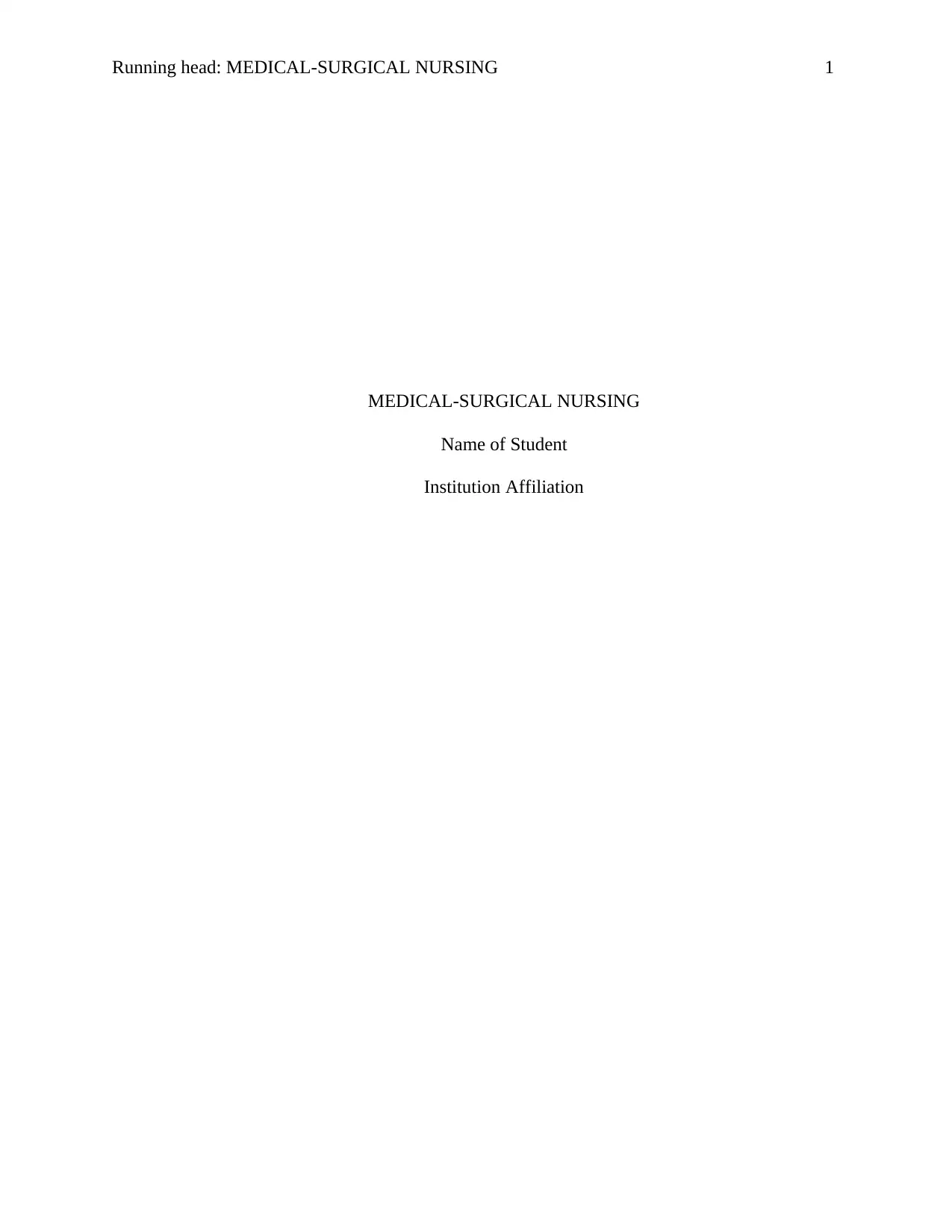
Running head: MEDICAL-SURGICAL NURSING 1
MEDICAL-SURGICAL NURSING
Name of Student
Institution Affiliation
MEDICAL-SURGICAL NURSING
Name of Student
Institution Affiliation
Paraphrase This Document
Need a fresh take? Get an instant paraphrase of this document with our AI Paraphraser
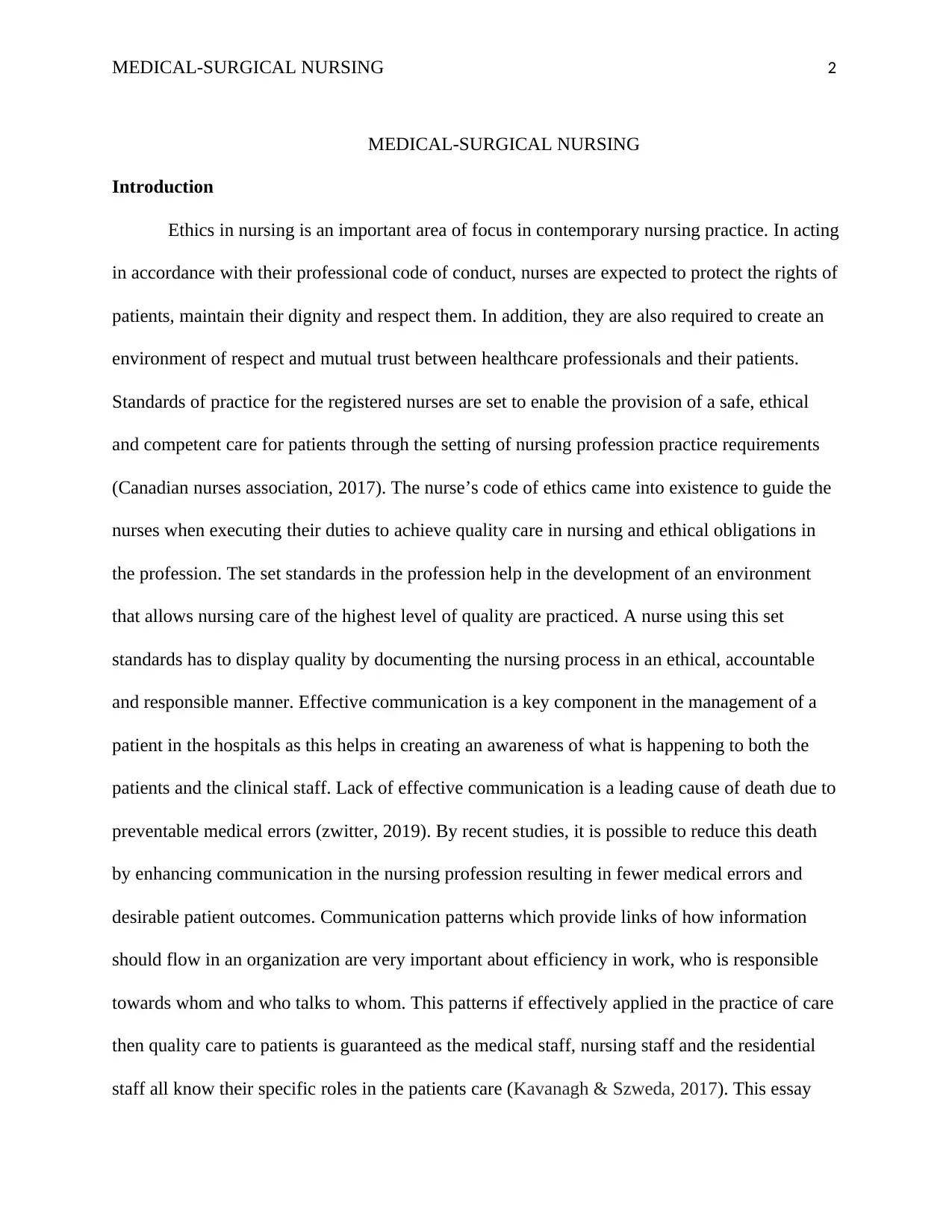
MEDICAL-SURGICAL NURSING 2
MEDICAL-SURGICAL NURSING
Introduction
Ethics in nursing is an important area of focus in contemporary nursing practice. In acting
in accordance with their professional code of conduct, nurses are expected to protect the rights of
patients, maintain their dignity and respect them. In addition, they are also required to create an
environment of respect and mutual trust between healthcare professionals and their patients.
Standards of practice for the registered nurses are set to enable the provision of a safe, ethical
and competent care for patients through the setting of nursing profession practice requirements
(Canadian nurses association, 2017). The nurse’s code of ethics came into existence to guide the
nurses when executing their duties to achieve quality care in nursing and ethical obligations in
the profession. The set standards in the profession help in the development of an environment
that allows nursing care of the highest level of quality are practiced. A nurse using this set
standards has to display quality by documenting the nursing process in an ethical, accountable
and responsible manner. Effective communication is a key component in the management of a
patient in the hospitals as this helps in creating an awareness of what is happening to both the
patients and the clinical staff. Lack of effective communication is a leading cause of death due to
preventable medical errors (zwitter, 2019). By recent studies, it is possible to reduce this death
by enhancing communication in the nursing profession resulting in fewer medical errors and
desirable patient outcomes. Communication patterns which provide links of how information
should flow in an organization are very important about efficiency in work, who is responsible
towards whom and who talks to whom. This patterns if effectively applied in the practice of care
then quality care to patients is guaranteed as the medical staff, nursing staff and the residential
staff all know their specific roles in the patients care (Kavanagh & Szweda, 2017). This essay
MEDICAL-SURGICAL NURSING
Introduction
Ethics in nursing is an important area of focus in contemporary nursing practice. In acting
in accordance with their professional code of conduct, nurses are expected to protect the rights of
patients, maintain their dignity and respect them. In addition, they are also required to create an
environment of respect and mutual trust between healthcare professionals and their patients.
Standards of practice for the registered nurses are set to enable the provision of a safe, ethical
and competent care for patients through the setting of nursing profession practice requirements
(Canadian nurses association, 2017). The nurse’s code of ethics came into existence to guide the
nurses when executing their duties to achieve quality care in nursing and ethical obligations in
the profession. The set standards in the profession help in the development of an environment
that allows nursing care of the highest level of quality are practiced. A nurse using this set
standards has to display quality by documenting the nursing process in an ethical, accountable
and responsible manner. Effective communication is a key component in the management of a
patient in the hospitals as this helps in creating an awareness of what is happening to both the
patients and the clinical staff. Lack of effective communication is a leading cause of death due to
preventable medical errors (zwitter, 2019). By recent studies, it is possible to reduce this death
by enhancing communication in the nursing profession resulting in fewer medical errors and
desirable patient outcomes. Communication patterns which provide links of how information
should flow in an organization are very important about efficiency in work, who is responsible
towards whom and who talks to whom. This patterns if effectively applied in the practice of care
then quality care to patients is guaranteed as the medical staff, nursing staff and the residential
staff all know their specific roles in the patients care (Kavanagh & Szweda, 2017). This essay
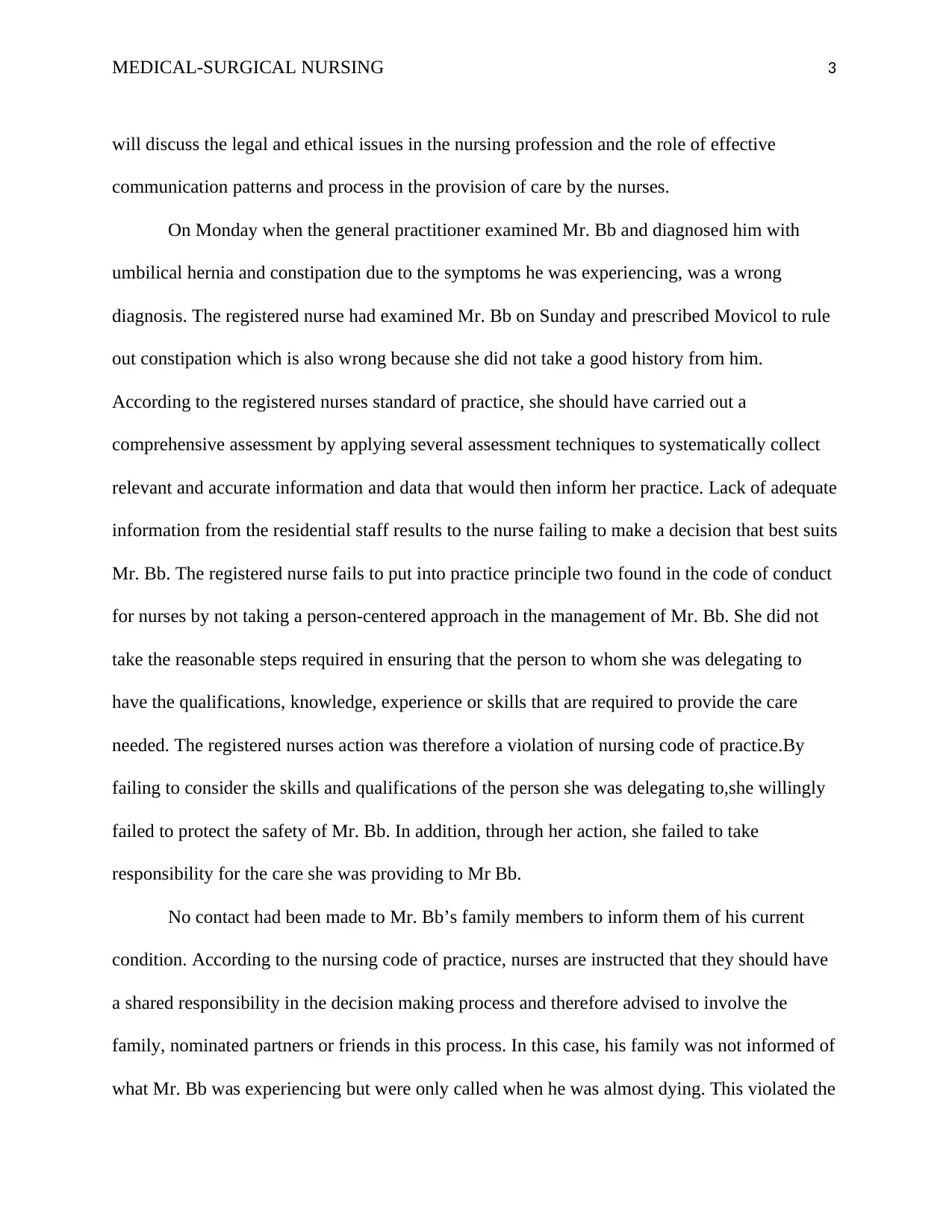
MEDICAL-SURGICAL NURSING 3
will discuss the legal and ethical issues in the nursing profession and the role of effective
communication patterns and process in the provision of care by the nurses.
On Monday when the general practitioner examined Mr. Bb and diagnosed him with
umbilical hernia and constipation due to the symptoms he was experiencing, was a wrong
diagnosis. The registered nurse had examined Mr. Bb on Sunday and prescribed Movicol to rule
out constipation which is also wrong because she did not take a good history from him.
According to the registered nurses standard of practice, she should have carried out a
comprehensive assessment by applying several assessment techniques to systematically collect
relevant and accurate information and data that would then inform her practice. Lack of adequate
information from the residential staff results to the nurse failing to make a decision that best suits
Mr. Bb. The registered nurse fails to put into practice principle two found in the code of conduct
for nurses by not taking a person-centered approach in the management of Mr. Bb. She did not
take the reasonable steps required in ensuring that the person to whom she was delegating to
have the qualifications, knowledge, experience or skills that are required to provide the care
needed. The registered nurses action was therefore a violation of nursing code of practice.By
failing to consider the skills and qualifications of the person she was delegating to,she willingly
failed to protect the safety of Mr. Bb. In addition, through her action, she failed to take
responsibility for the care she was providing to Mr Bb.
No contact had been made to Mr. Bb’s family members to inform them of his current
condition. According to the nursing code of practice, nurses are instructed that they should have
a shared responsibility in the decision making process and therefore advised to involve the
family, nominated partners or friends in this process. In this case, his family was not informed of
what Mr. Bb was experiencing but were only called when he was almost dying. This violated the
will discuss the legal and ethical issues in the nursing profession and the role of effective
communication patterns and process in the provision of care by the nurses.
On Monday when the general practitioner examined Mr. Bb and diagnosed him with
umbilical hernia and constipation due to the symptoms he was experiencing, was a wrong
diagnosis. The registered nurse had examined Mr. Bb on Sunday and prescribed Movicol to rule
out constipation which is also wrong because she did not take a good history from him.
According to the registered nurses standard of practice, she should have carried out a
comprehensive assessment by applying several assessment techniques to systematically collect
relevant and accurate information and data that would then inform her practice. Lack of adequate
information from the residential staff results to the nurse failing to make a decision that best suits
Mr. Bb. The registered nurse fails to put into practice principle two found in the code of conduct
for nurses by not taking a person-centered approach in the management of Mr. Bb. She did not
take the reasonable steps required in ensuring that the person to whom she was delegating to
have the qualifications, knowledge, experience or skills that are required to provide the care
needed. The registered nurses action was therefore a violation of nursing code of practice.By
failing to consider the skills and qualifications of the person she was delegating to,she willingly
failed to protect the safety of Mr. Bb. In addition, through her action, she failed to take
responsibility for the care she was providing to Mr Bb.
No contact had been made to Mr. Bb’s family members to inform them of his current
condition. According to the nursing code of practice, nurses are instructed that they should have
a shared responsibility in the decision making process and therefore advised to involve the
family, nominated partners or friends in this process. In this case, his family was not informed of
what Mr. Bb was experiencing but were only called when he was almost dying. This violated the
⊘ This is a preview!⊘
Do you want full access?
Subscribe today to unlock all pages.

Trusted by 1+ million students worldwide
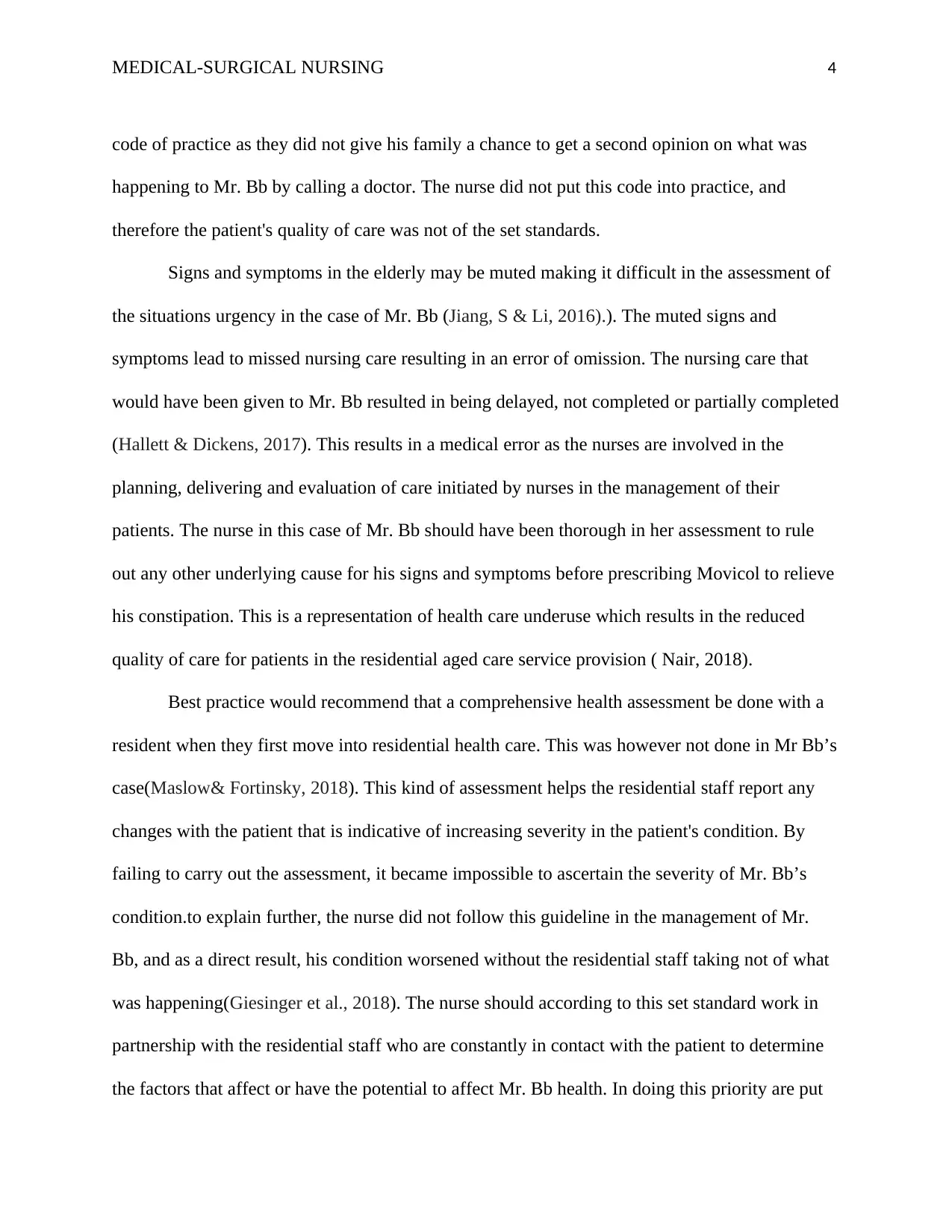
MEDICAL-SURGICAL NURSING 4
code of practice as they did not give his family a chance to get a second opinion on what was
happening to Mr. Bb by calling a doctor. The nurse did not put this code into practice, and
therefore the patient's quality of care was not of the set standards.
Signs and symptoms in the elderly may be muted making it difficult in the assessment of
the situations urgency in the case of Mr. Bb (Jiang, S & Li, 2016).). The muted signs and
symptoms lead to missed nursing care resulting in an error of omission. The nursing care that
would have been given to Mr. Bb resulted in being delayed, not completed or partially completed
(Hallett & Dickens, 2017). This results in a medical error as the nurses are involved in the
planning, delivering and evaluation of care initiated by nurses in the management of their
patients. The nurse in this case of Mr. Bb should have been thorough in her assessment to rule
out any other underlying cause for his signs and symptoms before prescribing Movicol to relieve
his constipation. This is a representation of health care underuse which results in the reduced
quality of care for patients in the residential aged care service provision ( Nair, 2018).
Best practice would recommend that a comprehensive health assessment be done with a
resident when they first move into residential health care. This was however not done in Mr Bb’s
case(Maslow& Fortinsky, 2018). This kind of assessment helps the residential staff report any
changes with the patient that is indicative of increasing severity in the patient's condition. By
failing to carry out the assessment, it became impossible to ascertain the severity of Mr. Bb’s
condition.to explain further, the nurse did not follow this guideline in the management of Mr.
Bb, and as a direct result, his condition worsened without the residential staff taking not of what
was happening(Giesinger et al., 2018). The nurse should according to this set standard work in
partnership with the residential staff who are constantly in contact with the patient to determine
the factors that affect or have the potential to affect Mr. Bb health. In doing this priority are put
code of practice as they did not give his family a chance to get a second opinion on what was
happening to Mr. Bb by calling a doctor. The nurse did not put this code into practice, and
therefore the patient's quality of care was not of the set standards.
Signs and symptoms in the elderly may be muted making it difficult in the assessment of
the situations urgency in the case of Mr. Bb (Jiang, S & Li, 2016).). The muted signs and
symptoms lead to missed nursing care resulting in an error of omission. The nursing care that
would have been given to Mr. Bb resulted in being delayed, not completed or partially completed
(Hallett & Dickens, 2017). This results in a medical error as the nurses are involved in the
planning, delivering and evaluation of care initiated by nurses in the management of their
patients. The nurse in this case of Mr. Bb should have been thorough in her assessment to rule
out any other underlying cause for his signs and symptoms before prescribing Movicol to relieve
his constipation. This is a representation of health care underuse which results in the reduced
quality of care for patients in the residential aged care service provision ( Nair, 2018).
Best practice would recommend that a comprehensive health assessment be done with a
resident when they first move into residential health care. This was however not done in Mr Bb’s
case(Maslow& Fortinsky, 2018). This kind of assessment helps the residential staff report any
changes with the patient that is indicative of increasing severity in the patient's condition. By
failing to carry out the assessment, it became impossible to ascertain the severity of Mr. Bb’s
condition.to explain further, the nurse did not follow this guideline in the management of Mr.
Bb, and as a direct result, his condition worsened without the residential staff taking not of what
was happening(Giesinger et al., 2018). The nurse should according to this set standard work in
partnership with the residential staff who are constantly in contact with the patient to determine
the factors that affect or have the potential to affect Mr. Bb health. In doing this priority are put
Paraphrase This Document
Need a fresh take? Get an instant paraphrase of this document with our AI Paraphraser
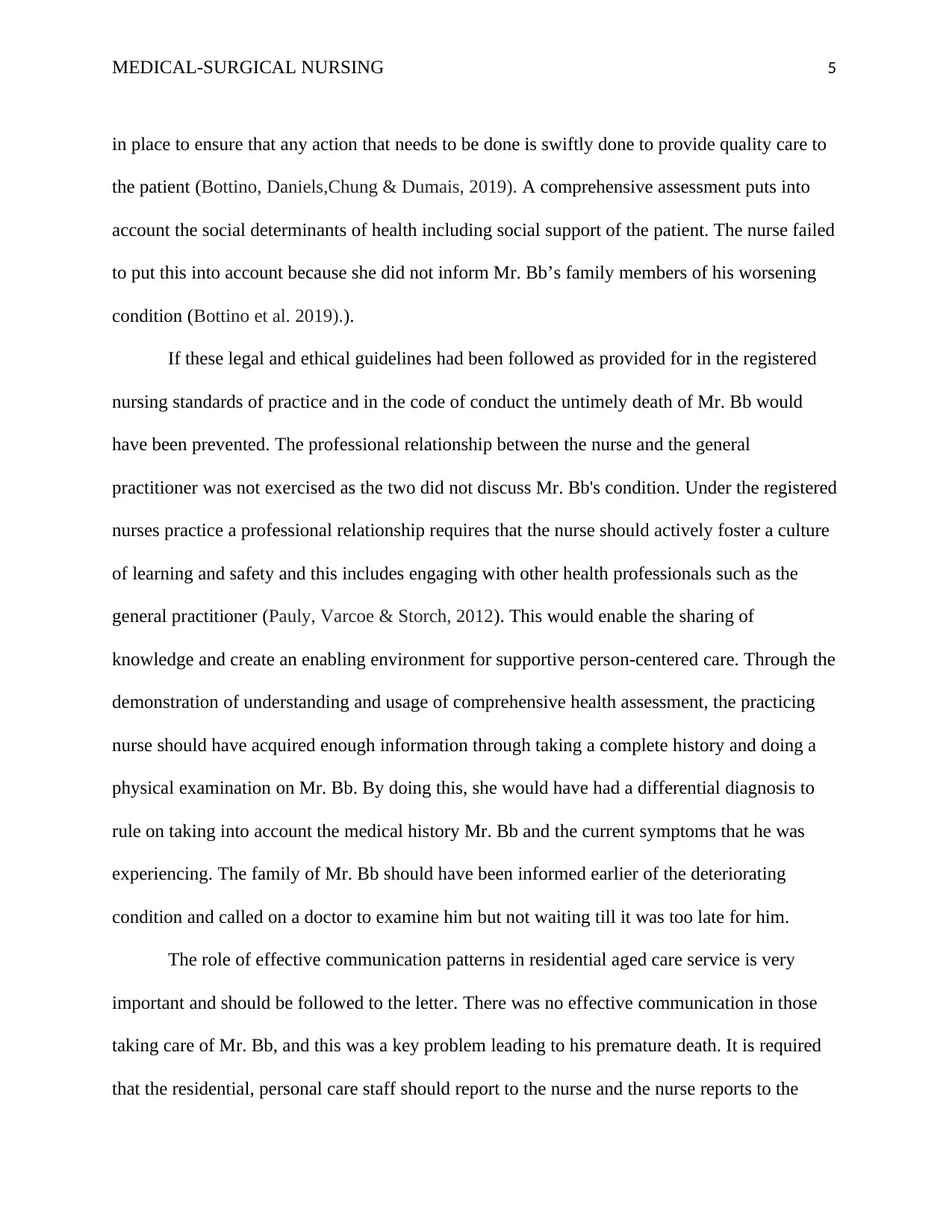
MEDICAL-SURGICAL NURSING 5
in place to ensure that any action that needs to be done is swiftly done to provide quality care to
the patient (Bottino, Daniels,Chung & Dumais, 2019). A comprehensive assessment puts into
account the social determinants of health including social support of the patient. The nurse failed
to put this into account because she did not inform Mr. Bb’s family members of his worsening
condition (Bottino et al. 2019).).
If these legal and ethical guidelines had been followed as provided for in the registered
nursing standards of practice and in the code of conduct the untimely death of Mr. Bb would
have been prevented. The professional relationship between the nurse and the general
practitioner was not exercised as the two did not discuss Mr. Bb's condition. Under the registered
nurses practice a professional relationship requires that the nurse should actively foster a culture
of learning and safety and this includes engaging with other health professionals such as the
general practitioner (Pauly, Varcoe & Storch, 2012). This would enable the sharing of
knowledge and create an enabling environment for supportive person-centered care. Through the
demonstration of understanding and usage of comprehensive health assessment, the practicing
nurse should have acquired enough information through taking a complete history and doing a
physical examination on Mr. Bb. By doing this, she would have had a differential diagnosis to
rule on taking into account the medical history Mr. Bb and the current symptoms that he was
experiencing. The family of Mr. Bb should have been informed earlier of the deteriorating
condition and called on a doctor to examine him but not waiting till it was too late for him.
The role of effective communication patterns in residential aged care service is very
important and should be followed to the letter. There was no effective communication in those
taking care of Mr. Bb, and this was a key problem leading to his premature death. It is required
that the residential, personal care staff should report to the nurse and the nurse reports to the
in place to ensure that any action that needs to be done is swiftly done to provide quality care to
the patient (Bottino, Daniels,Chung & Dumais, 2019). A comprehensive assessment puts into
account the social determinants of health including social support of the patient. The nurse failed
to put this into account because she did not inform Mr. Bb’s family members of his worsening
condition (Bottino et al. 2019).).
If these legal and ethical guidelines had been followed as provided for in the registered
nursing standards of practice and in the code of conduct the untimely death of Mr. Bb would
have been prevented. The professional relationship between the nurse and the general
practitioner was not exercised as the two did not discuss Mr. Bb's condition. Under the registered
nurses practice a professional relationship requires that the nurse should actively foster a culture
of learning and safety and this includes engaging with other health professionals such as the
general practitioner (Pauly, Varcoe & Storch, 2012). This would enable the sharing of
knowledge and create an enabling environment for supportive person-centered care. Through the
demonstration of understanding and usage of comprehensive health assessment, the practicing
nurse should have acquired enough information through taking a complete history and doing a
physical examination on Mr. Bb. By doing this, she would have had a differential diagnosis to
rule on taking into account the medical history Mr. Bb and the current symptoms that he was
experiencing. The family of Mr. Bb should have been informed earlier of the deteriorating
condition and called on a doctor to examine him but not waiting till it was too late for him.
The role of effective communication patterns in residential aged care service is very
important and should be followed to the letter. There was no effective communication in those
taking care of Mr. Bb, and this was a key problem leading to his premature death. It is required
that the residential, personal care staff should report to the nurse and the nurse reports to the
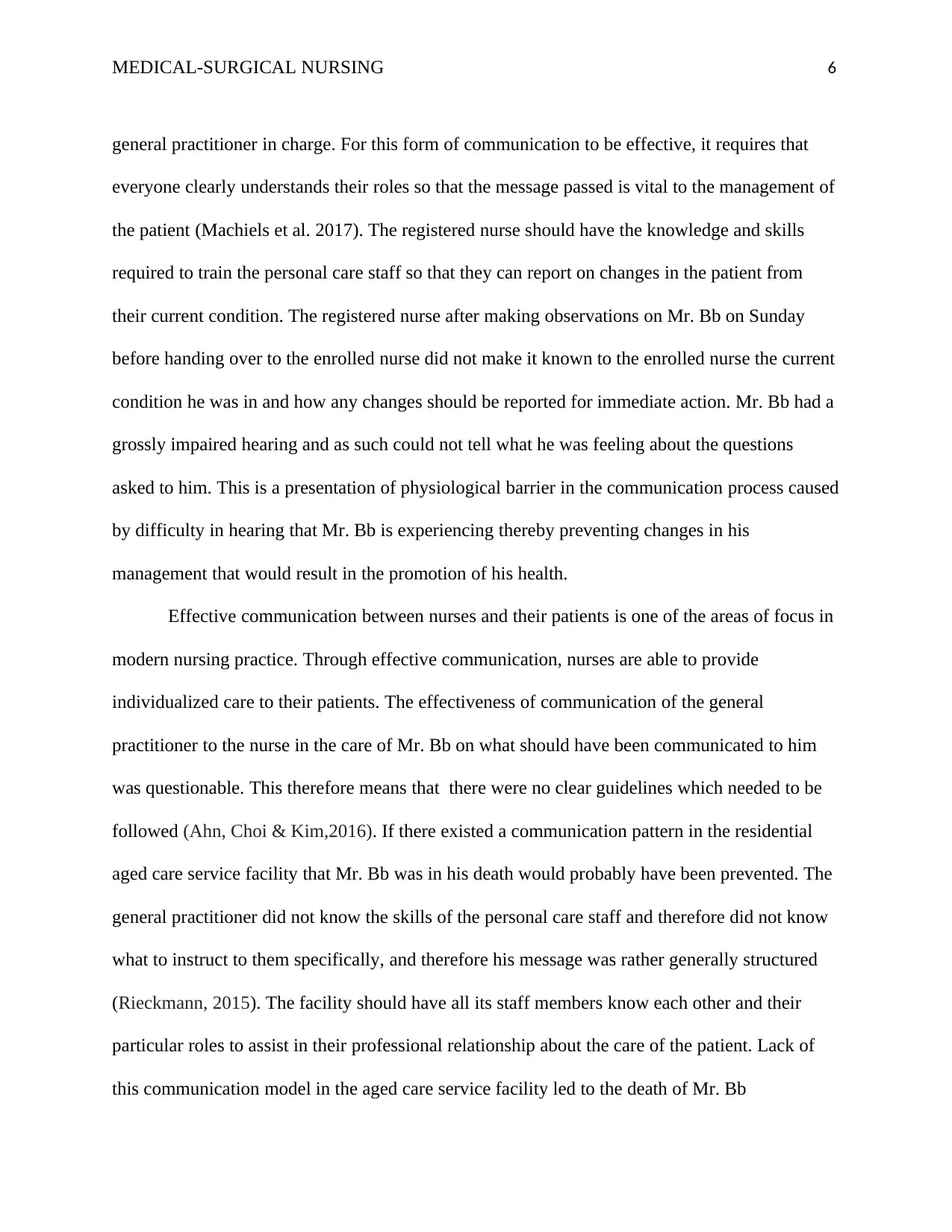
MEDICAL-SURGICAL NURSING 6
general practitioner in charge. For this form of communication to be effective, it requires that
everyone clearly understands their roles so that the message passed is vital to the management of
the patient (Machiels et al. 2017). The registered nurse should have the knowledge and skills
required to train the personal care staff so that they can report on changes in the patient from
their current condition. The registered nurse after making observations on Mr. Bb on Sunday
before handing over to the enrolled nurse did not make it known to the enrolled nurse the current
condition he was in and how any changes should be reported for immediate action. Mr. Bb had a
grossly impaired hearing and as such could not tell what he was feeling about the questions
asked to him. This is a presentation of physiological barrier in the communication process caused
by difficulty in hearing that Mr. Bb is experiencing thereby preventing changes in his
management that would result in the promotion of his health.
Effective communication between nurses and their patients is one of the areas of focus in
modern nursing practice. Through effective communication, nurses are able to provide
individualized care to their patients. The effectiveness of communication of the general
practitioner to the nurse in the care of Mr. Bb on what should have been communicated to him
was questionable. This therefore means that there were no clear guidelines which needed to be
followed (Ahn, Choi & Kim,2016). If there existed a communication pattern in the residential
aged care service facility that Mr. Bb was in his death would probably have been prevented. The
general practitioner did not know the skills of the personal care staff and therefore did not know
what to instruct to them specifically, and therefore his message was rather generally structured
(Rieckmann, 2015). The facility should have all its staff members know each other and their
particular roles to assist in their professional relationship about the care of the patient. Lack of
this communication model in the aged care service facility led to the death of Mr. Bb
general practitioner in charge. For this form of communication to be effective, it requires that
everyone clearly understands their roles so that the message passed is vital to the management of
the patient (Machiels et al. 2017). The registered nurse should have the knowledge and skills
required to train the personal care staff so that they can report on changes in the patient from
their current condition. The registered nurse after making observations on Mr. Bb on Sunday
before handing over to the enrolled nurse did not make it known to the enrolled nurse the current
condition he was in and how any changes should be reported for immediate action. Mr. Bb had a
grossly impaired hearing and as such could not tell what he was feeling about the questions
asked to him. This is a presentation of physiological barrier in the communication process caused
by difficulty in hearing that Mr. Bb is experiencing thereby preventing changes in his
management that would result in the promotion of his health.
Effective communication between nurses and their patients is one of the areas of focus in
modern nursing practice. Through effective communication, nurses are able to provide
individualized care to their patients. The effectiveness of communication of the general
practitioner to the nurse in the care of Mr. Bb on what should have been communicated to him
was questionable. This therefore means that there were no clear guidelines which needed to be
followed (Ahn, Choi & Kim,2016). If there existed a communication pattern in the residential
aged care service facility that Mr. Bb was in his death would probably have been prevented. The
general practitioner did not know the skills of the personal care staff and therefore did not know
what to instruct to them specifically, and therefore his message was rather generally structured
(Rieckmann, 2015). The facility should have all its staff members know each other and their
particular roles to assist in their professional relationship about the care of the patient. Lack of
this communication model in the aged care service facility led to the death of Mr. Bb
⊘ This is a preview!⊘
Do you want full access?
Subscribe today to unlock all pages.

Trusted by 1+ million students worldwide
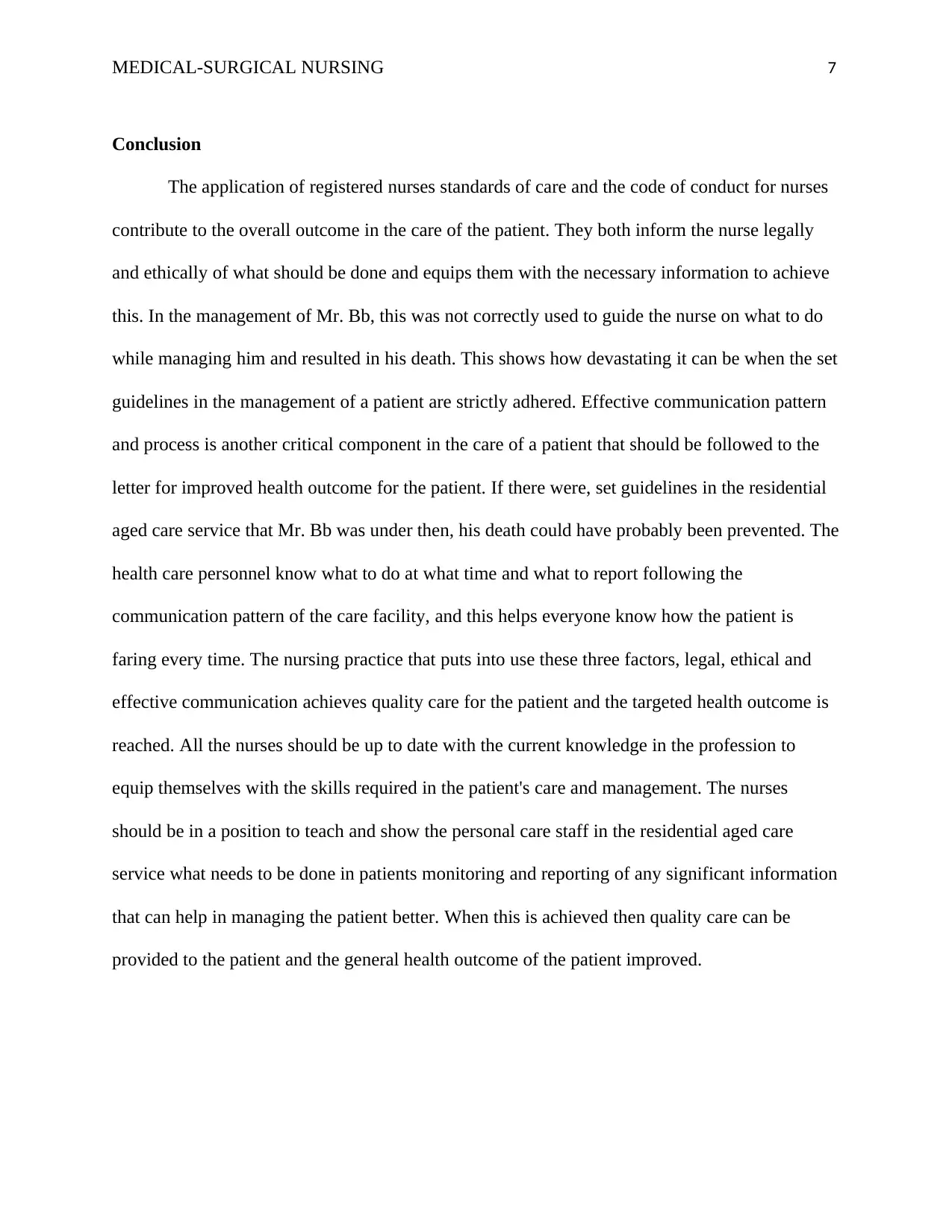
MEDICAL-SURGICAL NURSING 7
Conclusion
The application of registered nurses standards of care and the code of conduct for nurses
contribute to the overall outcome in the care of the patient. They both inform the nurse legally
and ethically of what should be done and equips them with the necessary information to achieve
this. In the management of Mr. Bb, this was not correctly used to guide the nurse on what to do
while managing him and resulted in his death. This shows how devastating it can be when the set
guidelines in the management of a patient are strictly adhered. Effective communication pattern
and process is another critical component in the care of a patient that should be followed to the
letter for improved health outcome for the patient. If there were, set guidelines in the residential
aged care service that Mr. Bb was under then, his death could have probably been prevented. The
health care personnel know what to do at what time and what to report following the
communication pattern of the care facility, and this helps everyone know how the patient is
faring every time. The nursing practice that puts into use these three factors, legal, ethical and
effective communication achieves quality care for the patient and the targeted health outcome is
reached. All the nurses should be up to date with the current knowledge in the profession to
equip themselves with the skills required in the patient's care and management. The nurses
should be in a position to teach and show the personal care staff in the residential aged care
service what needs to be done in patients monitoring and reporting of any significant information
that can help in managing the patient better. When this is achieved then quality care can be
provided to the patient and the general health outcome of the patient improved.
Conclusion
The application of registered nurses standards of care and the code of conduct for nurses
contribute to the overall outcome in the care of the patient. They both inform the nurse legally
and ethically of what should be done and equips them with the necessary information to achieve
this. In the management of Mr. Bb, this was not correctly used to guide the nurse on what to do
while managing him and resulted in his death. This shows how devastating it can be when the set
guidelines in the management of a patient are strictly adhered. Effective communication pattern
and process is another critical component in the care of a patient that should be followed to the
letter for improved health outcome for the patient. If there were, set guidelines in the residential
aged care service that Mr. Bb was under then, his death could have probably been prevented. The
health care personnel know what to do at what time and what to report following the
communication pattern of the care facility, and this helps everyone know how the patient is
faring every time. The nursing practice that puts into use these three factors, legal, ethical and
effective communication achieves quality care for the patient and the targeted health outcome is
reached. All the nurses should be up to date with the current knowledge in the profession to
equip themselves with the skills required in the patient's care and management. The nurses
should be in a position to teach and show the personal care staff in the residential aged care
service what needs to be done in patients monitoring and reporting of any significant information
that can help in managing the patient better. When this is achieved then quality care can be
provided to the patient and the general health outcome of the patient improved.
Paraphrase This Document
Need a fresh take? Get an instant paraphrase of this document with our AI Paraphraser
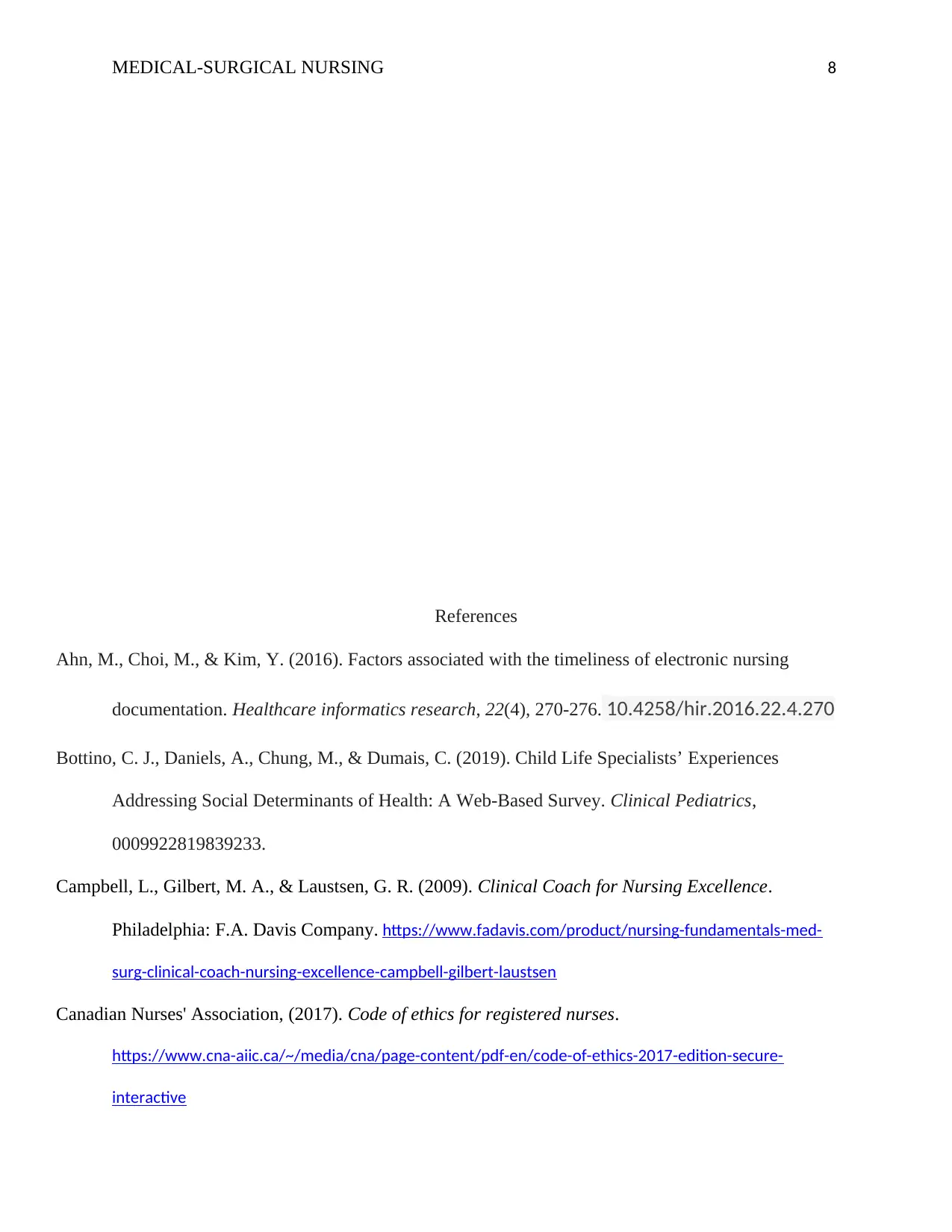
MEDICAL-SURGICAL NURSING 8
References
Ahn, M., Choi, M., & Kim, Y. (2016). Factors associated with the timeliness of electronic nursing
documentation. Healthcare informatics research, 22(4), 270-276. 10.4258/hir.2016.22.4.270
Bottino, C. J., Daniels, A., Chung, M., & Dumais, C. (2019). Child Life Specialists’ Experiences
Addressing Social Determinants of Health: A Web-Based Survey. Clinical Pediatrics,
0009922819839233.
Campbell, L., Gilbert, M. A., & Laustsen, G. R. (2009). Clinical Coach for Nursing Excellence.
Philadelphia: F.A. Davis Company. https://www.fadavis.com/product/nursing-fundamentals-med-
surg-clinical-coach-nursing-excellence-campbell-gilbert-laustsen
Canadian Nurses' Association, (2017). Code of ethics for registered nurses.
https://www.cna-aiic.ca/~/media/cna/page-content/pdf-en/code-of-ethics-2017-edition-secure-
interactive
References
Ahn, M., Choi, M., & Kim, Y. (2016). Factors associated with the timeliness of electronic nursing
documentation. Healthcare informatics research, 22(4), 270-276. 10.4258/hir.2016.22.4.270
Bottino, C. J., Daniels, A., Chung, M., & Dumais, C. (2019). Child Life Specialists’ Experiences
Addressing Social Determinants of Health: A Web-Based Survey. Clinical Pediatrics,
0009922819839233.
Campbell, L., Gilbert, M. A., & Laustsen, G. R. (2009). Clinical Coach for Nursing Excellence.
Philadelphia: F.A. Davis Company. https://www.fadavis.com/product/nursing-fundamentals-med-
surg-clinical-coach-nursing-excellence-campbell-gilbert-laustsen
Canadian Nurses' Association, (2017). Code of ethics for registered nurses.
https://www.cna-aiic.ca/~/media/cna/page-content/pdf-en/code-of-ethics-2017-edition-secure-
interactive
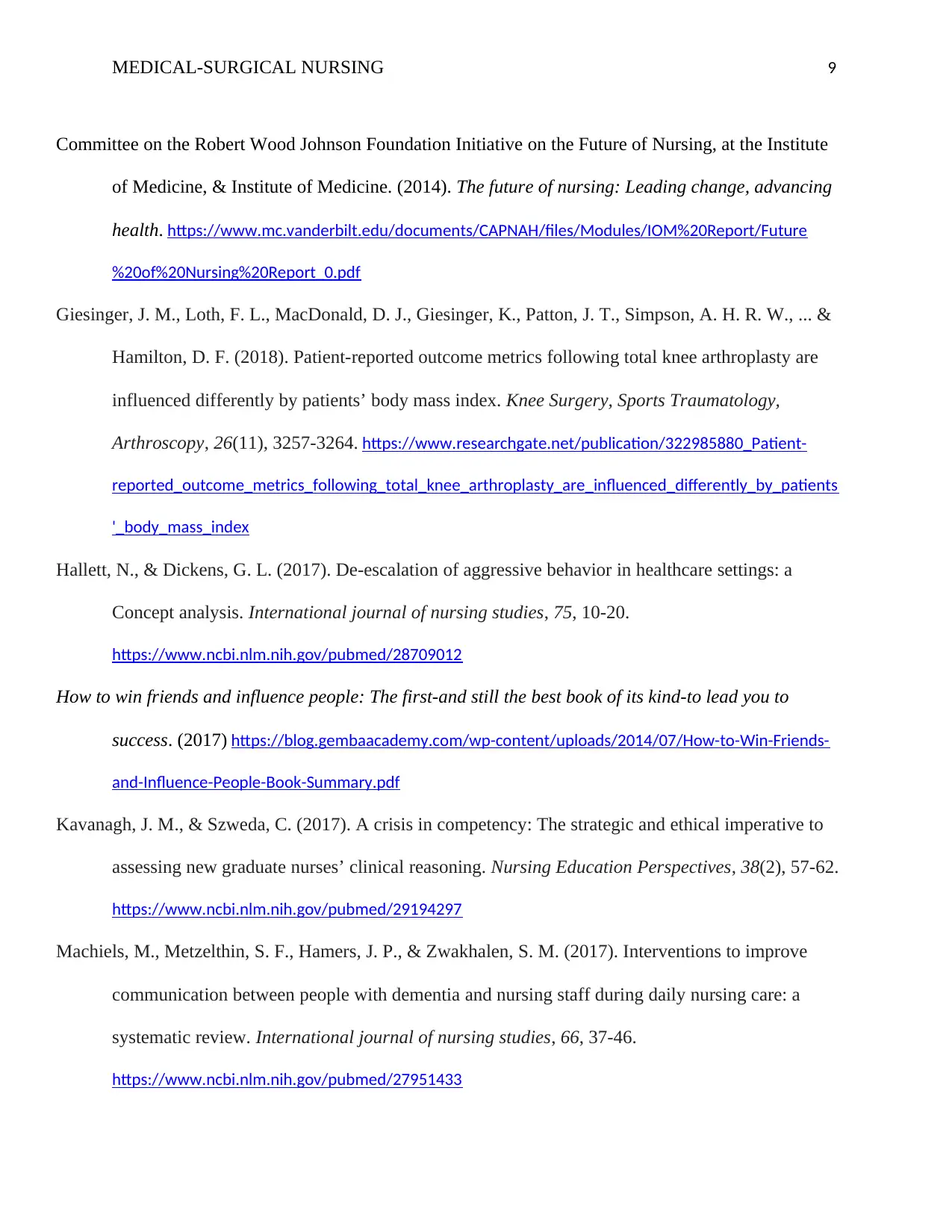
MEDICAL-SURGICAL NURSING 9
Committee on the Robert Wood Johnson Foundation Initiative on the Future of Nursing, at the Institute
of Medicine, & Institute of Medicine. (2014). The future of nursing: Leading change, advancing
health. https://www.mc.vanderbilt.edu/documents/CAPNAH/files/Modules/IOM%20Report/Future
%20of%20Nursing%20Report_0.pdf
Giesinger, J. M., Loth, F. L., MacDonald, D. J., Giesinger, K., Patton, J. T., Simpson, A. H. R. W., ... &
Hamilton, D. F. (2018). Patient-reported outcome metrics following total knee arthroplasty are
influenced differently by patients’ body mass index. Knee Surgery, Sports Traumatology,
Arthroscopy, 26(11), 3257-3264. https://www.researchgate.net/publication/322985880_Patient-
reported_outcome_metrics_following_total_knee_arthroplasty_are_influenced_differently_by_patients
'_body_mass_index
Hallett, N., & Dickens, G. L. (2017). De-escalation of aggressive behavior in healthcare settings: a
Concept analysis. International journal of nursing studies, 75, 10-20.
https://www.ncbi.nlm.nih.gov/pubmed/28709012
How to win friends and influence people: The first-and still the best book of its kind-to lead you to
success. (2017) https://blog.gembaacademy.com/wp-content/uploads/2014/07/How-to-Win-Friends-
and-Influence-People-Book-Summary.pdf
Kavanagh, J. M., & Szweda, C. (2017). A crisis in competency: The strategic and ethical imperative to
assessing new graduate nurses’ clinical reasoning. Nursing Education Perspectives, 38(2), 57-62.
https://www.ncbi.nlm.nih.gov/pubmed/29194297
Machiels, M., Metzelthin, S. F., Hamers, J. P., & Zwakhalen, S. M. (2017). Interventions to improve
communication between people with dementia and nursing staff during daily nursing care: a
systematic review. International journal of nursing studies, 66, 37-46.
https://www.ncbi.nlm.nih.gov/pubmed/27951433
Committee on the Robert Wood Johnson Foundation Initiative on the Future of Nursing, at the Institute
of Medicine, & Institute of Medicine. (2014). The future of nursing: Leading change, advancing
health. https://www.mc.vanderbilt.edu/documents/CAPNAH/files/Modules/IOM%20Report/Future
%20of%20Nursing%20Report_0.pdf
Giesinger, J. M., Loth, F. L., MacDonald, D. J., Giesinger, K., Patton, J. T., Simpson, A. H. R. W., ... &
Hamilton, D. F. (2018). Patient-reported outcome metrics following total knee arthroplasty are
influenced differently by patients’ body mass index. Knee Surgery, Sports Traumatology,
Arthroscopy, 26(11), 3257-3264. https://www.researchgate.net/publication/322985880_Patient-
reported_outcome_metrics_following_total_knee_arthroplasty_are_influenced_differently_by_patients
'_body_mass_index
Hallett, N., & Dickens, G. L. (2017). De-escalation of aggressive behavior in healthcare settings: a
Concept analysis. International journal of nursing studies, 75, 10-20.
https://www.ncbi.nlm.nih.gov/pubmed/28709012
How to win friends and influence people: The first-and still the best book of its kind-to lead you to
success. (2017) https://blog.gembaacademy.com/wp-content/uploads/2014/07/How-to-Win-Friends-
and-Influence-People-Book-Summary.pdf
Kavanagh, J. M., & Szweda, C. (2017). A crisis in competency: The strategic and ethical imperative to
assessing new graduate nurses’ clinical reasoning. Nursing Education Perspectives, 38(2), 57-62.
https://www.ncbi.nlm.nih.gov/pubmed/29194297
Machiels, M., Metzelthin, S. F., Hamers, J. P., & Zwakhalen, S. M. (2017). Interventions to improve
communication between people with dementia and nursing staff during daily nursing care: a
systematic review. International journal of nursing studies, 66, 37-46.
https://www.ncbi.nlm.nih.gov/pubmed/27951433
⊘ This is a preview!⊘
Do you want full access?
Subscribe today to unlock all pages.

Trusted by 1+ million students worldwide
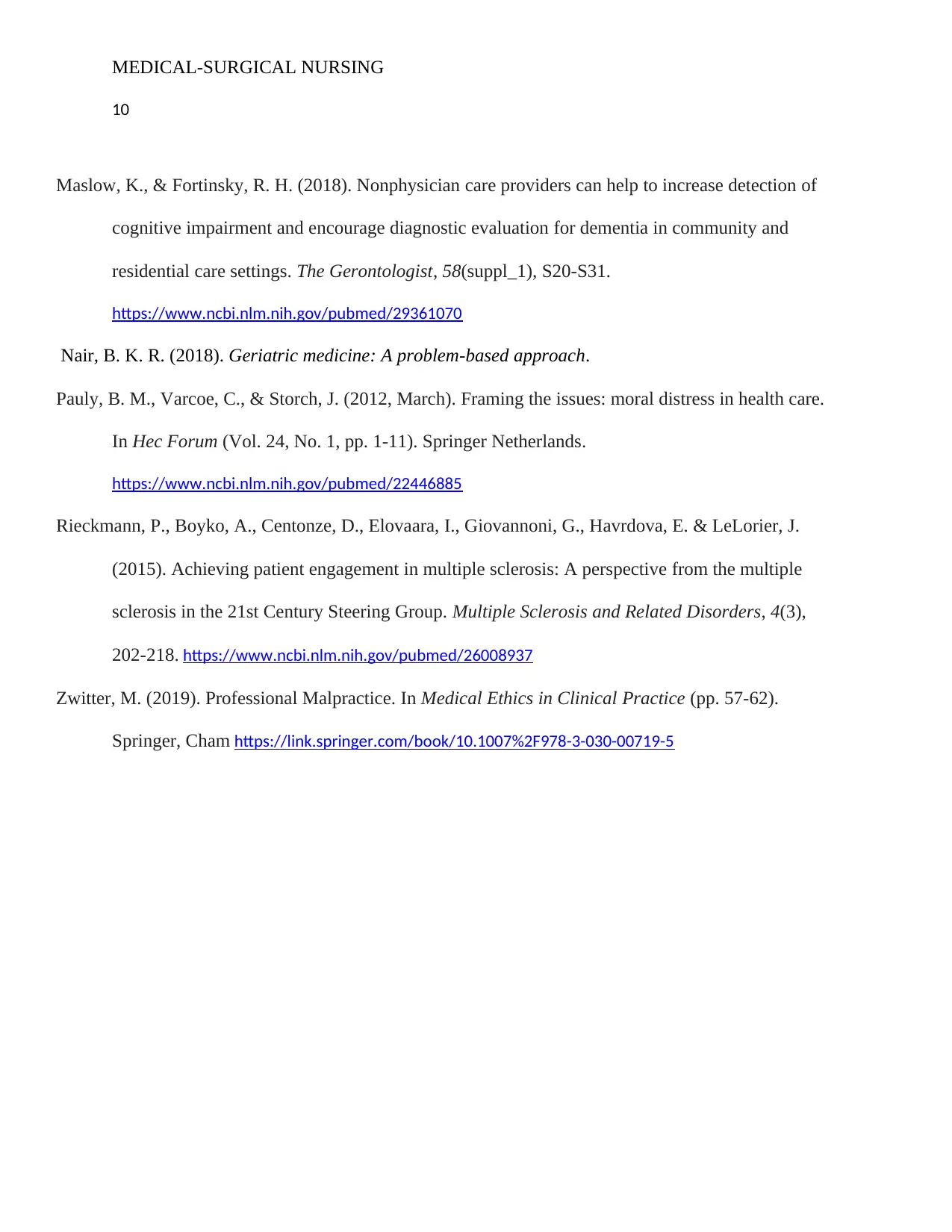
MEDICAL-SURGICAL NURSING
10
Maslow, K., & Fortinsky, R. H. (2018). Nonphysician care providers can help to increase detection of
cognitive impairment and encourage diagnostic evaluation for dementia in community and
residential care settings. The Gerontologist, 58(suppl_1), S20-S31.
https://www.ncbi.nlm.nih.gov/pubmed/29361070
Nair, B. K. R. (2018). Geriatric medicine: A problem-based approach.
Pauly, B. M., Varcoe, C., & Storch, J. (2012, March). Framing the issues: moral distress in health care.
In Hec Forum (Vol. 24, No. 1, pp. 1-11). Springer Netherlands.
https://www.ncbi.nlm.nih.gov/pubmed/22446885
Rieckmann, P., Boyko, A., Centonze, D., Elovaara, I., Giovannoni, G., Havrdova, E. & LeLorier, J.
(2015). Achieving patient engagement in multiple sclerosis: A perspective from the multiple
sclerosis in the 21st Century Steering Group. Multiple Sclerosis and Related Disorders, 4(3),
202-218. https://www.ncbi.nlm.nih.gov/pubmed/26008937
Zwitter, M. (2019). Professional Malpractice. In Medical Ethics in Clinical Practice (pp. 57-62).
Springer, Cham https://link.springer.com/book/10.1007%2F978-3-030-00719-5
10
Maslow, K., & Fortinsky, R. H. (2018). Nonphysician care providers can help to increase detection of
cognitive impairment and encourage diagnostic evaluation for dementia in community and
residential care settings. The Gerontologist, 58(suppl_1), S20-S31.
https://www.ncbi.nlm.nih.gov/pubmed/29361070
Nair, B. K. R. (2018). Geriatric medicine: A problem-based approach.
Pauly, B. M., Varcoe, C., & Storch, J. (2012, March). Framing the issues: moral distress in health care.
In Hec Forum (Vol. 24, No. 1, pp. 1-11). Springer Netherlands.
https://www.ncbi.nlm.nih.gov/pubmed/22446885
Rieckmann, P., Boyko, A., Centonze, D., Elovaara, I., Giovannoni, G., Havrdova, E. & LeLorier, J.
(2015). Achieving patient engagement in multiple sclerosis: A perspective from the multiple
sclerosis in the 21st Century Steering Group. Multiple Sclerosis and Related Disorders, 4(3),
202-218. https://www.ncbi.nlm.nih.gov/pubmed/26008937
Zwitter, M. (2019). Professional Malpractice. In Medical Ethics in Clinical Practice (pp. 57-62).
Springer, Cham https://link.springer.com/book/10.1007%2F978-3-030-00719-5
1 out of 10
Related Documents
Your All-in-One AI-Powered Toolkit for Academic Success.
+13062052269
info@desklib.com
Available 24*7 on WhatsApp / Email
![[object Object]](/_next/static/media/star-bottom.7253800d.svg)
Unlock your academic potential
Copyright © 2020–2025 A2Z Services. All Rights Reserved. Developed and managed by ZUCOL.




